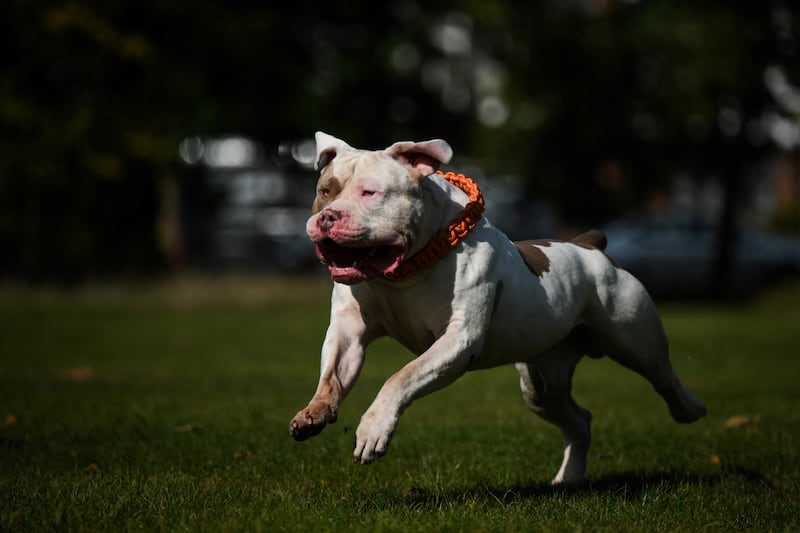Should XL bullies and similar dogs be banned and would it make any difference if they were?
That is the question facing the new high-level committee, set up by Minister for Rural and Community Development Heather Humphreys, which has been tasked to make recommendations on the future control of dogs.
The work of the committee has become even more pressing since the death this week of Nicole Morey in Co Limerick. The 23-year-old was attacked by her dogs and killed on Tuesday evening at a house in Ballyneety.
The case has sparked fresh debate about whether dogs such as the XL bully, which was involved in Morey’s death, should be banned in Ireland.
Trump-Zelenskiy clash ‘very unsettling’, says Taoiseach ahead of White House trip
Teenager and man (20s) killed as car hits gable wall in Donegal crash
Life without children: ‘I’d want the investment my mother had, but I don’t have it in me. I don’t have the grá for it’
Plans to base combat jets at Shannon airport at annual cost of €100m
Morey is not the first person to die in a dog attack in Ireland.
Teresa McDonagh (64) died in 2017 when she was attacked by three presa canario dogs as she called to her son’s home to visit her grandchildren in Co Galway.
A coroner’s court subsequently recommended the breed be added to the list of dangerous or restricted dog breeds and that such dogs should be restrained at all times and muzzled. The court also recommended that a special dog licence with special training should be introduced for owners of such breeds. None of this happened. Dogs on the State’s restricted list only have to be muzzled in public.
Seven-year-old Glen Murphy was killed when he was attacked by Rottweilers in a house in Dublin in 2020. Four-month-old Mia O’Connell was killed by a dachshund-terrier cross after it pulled the infant from her basket in Waterford in 2021.
Many injuries suffered by those who survived dog attacks have been severe and life changing. In 2022, nine-year-old Alejandro Mizsan received severe facial injuries when he was attacked by an XL bully dog while playing with friends in a green area at the Forgelands Estate in Enniscorthy, Co Wexford. His family urged legislators to outlaw the breed to ensure no other family has to go through the same experience.
[ Limerick dog attack: What is an XL bully and how dangerous are they?Opens in new window ]
In June 2021, 12-year-old Dubliner Darryl Brady-Graham was attacked by a dog on the restricted breeds list, requiring 1,690 stitches to his face.
More than 1,700 attacks on humans by dogs were reported to authorities between 2016-2021. According to the Department of Rural and Community Development, more than 300 people were injured due to dog attacks in 2022. A more recent investigation by the online news site Noteworthy, which contacted local authorities individually, found a 60 per cent rise in the number of dog attacks in 2023, putting the number of reported attacks that year in the region of 500.
Despite the number of attacks, no breed of dog has been banned in the Republic. XL bullies are not on the State’s restricted breeds list, but the department said that as a cross of breeds on the list they are covered and so legislation requires them to be muzzled in public and on a short lead held by people over the age of 16.
Dogs, including those on the Republic’s restricted list, are regularly bought and sold online, often as puppies with little or no training for either the dog or the owner. So, is an outright ban on some breeds necessary?
Nanci Creedon, a canine behaviour expert, and long-time advocate of education and training for dog owners this week said given the number of fatal attacks involving XL bullies, “for now, and until we finally start recording the data from these incidences, I am OK with a blanket ban on the breed”.

Addressing the Oireachtas agriculture committee late last year, she said: “The internet and social media is filled with incorrect, unscientific, and sometimes dangerous dog behaviour and training advice, to which the dog-owning public are turning to for lack of State-directed advice and education.”
She said that the most effective method of owner education would be to legislate for it to be mandatory to pass a theory test before obtaining a dog licence.
“Dog owners should have to be educated to a competent level before taking control of a dog that can cause harm if cared for the wrong way,” Creedon said.
Kildare-based vet Des Groome, who has extensive experience dealing with canines, said a ban on aggressive types of dogs was necessary, but “picking on certain breeds” is unlikely to be successful or popular. Dog cross breeds such as the XL bully, which has been involved in a number of high-profile attacks, could be renamed to get around such a ban.
Instead, Groome would ban certain dogs based on type: their muzzle-to-jaw ratio; their weight and height from the ground to their shoulders.
“Typically, for example, the bully types have a wider jaw than other dogs, stand more than 50cm and weigh more than 40kg, hence they are harder to control and do more harm when they bite,” Groome said.
According to Groome, a ban on dog types would have to be accompanied by a ban on breeding such dogs, as well as a ban on the importation of semen. The neutering of existing banned dogs would also be necessary.
Other recommendations include an increase in the number of dog wardens with more powers, including power to impose significant fines for transgressors.
“There are a lot of regulations already in place, but they need more enforcement,” Groome said.
Earlier this week, Minister for Environment Eamon Ryan came out in favour of an outright ban.
“They are not just a threat to their owner but the community. When you see a dog like that coming at you, you’re scared,” Ryan said.
The issue of enforcement is one fraught with difficulty. Asked about numbers of prosecutions, the Department of Justice referred the question to the Department of Housing and Local Government, which said the question should be addressed to local authorities.
The Department of Rural and Community Development is the lead department in legislating for the control of dogs. Minister for Rural and Community Development Heather Humphreys last November tripled on-the-spot fines to €300 for more serious offences under the Control of Dogs Act.

England and Wales have banned this breed of dog. Should Ireland follow?
According to the department’s website, only half of the 1,700 fixed charge fines issued in 2022 were paid. This week, the department was unable to say if the increase in fines has worked so far this year. It was also unable to say how many dogs from breeds on the restricted list had been seized each year or how many fines had been issued since the increase penalties.
The department also referred questions of this nature to local authorities, but its website notes its most recent compilation of annual statistics for 2022 was hampered by inconsistent responses from those local authorities.
The department said the figures for 2022 indicate there were 52 full-time and 22 part-time dog wardens employed in the country, an increase on the 2021 figures of 50 full-time and 21 part-time. Dog control services are funded in local authorities through income generated by licences, fines and own resources. Statistics for 2023 are expected to be published shortly.
The increase in fines is likely to be “useless” without more dog wardens, according to independent TD Seán Canney. He said the State did not have enough dog wardens to enforce dog control.
[ Taoiseach questions ‘need’ to own dangerous dog breeds after Wexford attackOpens in new window ]
Condemnation of dog attacks on people has always been swift. Following the attack on Alejandro Mizsan in 2022, then taoiseach Micheál Martin said the attack was “one child too many”.
Mr Martin said he was “disturbed” and “angry” and it was time to “go back to the drawing board” in relation to dog control. He tasked Humphreys with setting up a taskforce to review dog control, after which she set up the high-level committee in March this year to look at the issue.
“It is important for dog owners to be aware of their responsibilities, not just to the general public but also to their dogs,” Humphreys said in a recent Dáil debate.
This week Humphreys said that if the committee recommends some breeds should be banned, then that is what she would do.
Restricted dog breeds in Ireland
- American pit bull terrier
- English bull terrier
- Staffordshire bull terrier
- Bull mastiff
- Dobermann pinscher
- Rottweiler
- German shepherd (Alsatian)
- Rhodesian ridgeback
- Japanese Akita
- Japanese Tosa
- Ban dog – a cross or mixture of any of the above breeds or any strain of above dogs














